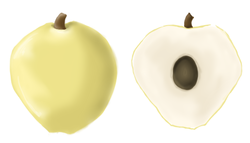
|
The Jedi were real? This article is part of the history of Clan Odan-Urr and isn't part of current events.
Please do not remove this tag or the contents. These articles exist for historic purposes.
|
- "“Never before had I seen such a brilliant purple in the wild in all my travels.”"
- ―Finn Ys’drol - Botanist
Found deep in the forests of Kamuekiko high up in the trees, these brilliant fruit-bearing flowers are sought out by all forest tribes as an elusive and rare treat. With a short growing and harvesting season, these flowers and their fruit became one of the signs of the spring season.
Appearance

A typical specimen consists of three layers of petals. The bottom layer closest to the stem consists of tiny white petals which stay this way throughout the growth cycle. The next layer in is the four very large dark purple petals that makes up the majority of the bloom. The last layer on the very inside consists of four smaller, lighter purple petals. These are found to overlay the gaps between the larger petals underneath.
In the center of the flower is golden pollen filaments and predominant round stamen. When fully in bloom, the flower is much larger than an average Humanoid hand and can weigh upwards of 2-3 pounds before bearing fruit. Attached to the thick, short stem is numerous dark green leaves with a smooth surface other than the bumpy middle ridge running down the entire leaf’s length.
The fruit produced by the plant are small in comparison to the flower’s size. The fruit typically has a yellow skin and has a short stem.
Description
Found by only the most skilled of Harakoans, the Oku flowers and fruit are located only on a specific type of tree high up in the canopy of the thick rainforest. The tree itself has smooth bark and very few branches lower on the trunk, giving the natives some trouble when trying to climb the trees to reach the tops.
The flowers and fruit that the plant produces can be fickle, only growing during after spring seasons of incredibly heavy rain. This results in some skipped years of growth during particularly dry spring seasons or an incredibly limited crop.
Unlike many other fruit bearing flowers, the Oku plant does not shed most of its original petals from the original growth in preparation of fruit production. Out of the three layers of petals found on the flower, only the biggest ones shed to allow the leaves to capture more sunlight and produce fruit. Once the fruit has reached maturation, the remaining petals fall, leaving the fruit ready to be picked.
Finn Ys’drol, the man who first documented these flowers and fruit on paper, described the taste of the fruit to be that of a cross of a tart apple and a sweet pear. The flesh of the fruit is an off white colour and very crisp; juicy due to the heavy rainfall needed to produce them. The skin colour most documented is a pale yellow, though some fruits produce green skin as well. The Oku fruit has a solitary seed in the middle and is entirely inedible. The average fruit size fits snuggly into the palm of an average Humanoid’s hand.
Cultivation and Uses
Cultivation of the fruits and flowers is considered dangerous and is only to be done by seasoned tree climbers. Depending on the crop that year, most flowers are left to grow into fruits, some of the trees harvested purely for the flowers themselves. Flowers are cut at the stem when harvested and carefully stored until use, the flowers typically used within days of being harvested. Fruits are picked to have a small bit of stem left on them and stored in cool places where animals cannot access them.
All parts of the flower is used. The darkest of the petals is prepared in a way to be used as dye for clothing or body paint for females; typically used on and near the eyelids for extra decoration while celebrating the return of spring. The remainder of the petals which carry a heavier floral scent are typically used as potpourri or in tea mixtures with other herbs. The leaves are used in cooking; both for wrapping foods to be cooked or are grilled upon. The sturdy leaves allow for this use.
When harvested, fruits are generally consumed raw during their peak ripeness, the remainder of the fruits dried or cooked into other dishes when reaching over-ripeness. The seeds are roasted and ground up, some tribes claiming it carries medicinal properties. Some seeds are planted in different parts of the forest in hopes of producing more trees, but it is currently undocumented if this effort has succeeded or not.